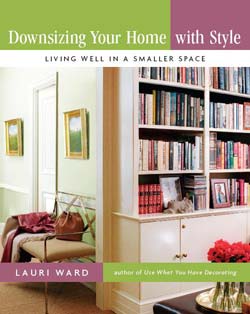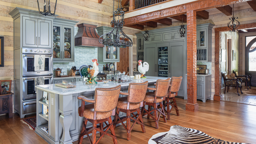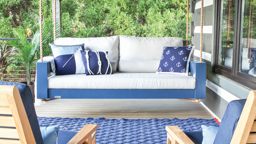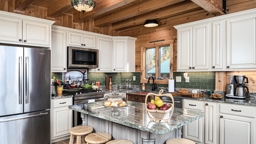 Lauri Ward, designer, decorating pioneer and author of "Use What You Have Decorating" and "Downsizing Your Home With Style: Living Well in a Smaller Space," shares her ideas on how to get maximum style in a small home:
Lauri Ward, designer, decorating pioneer and author of "Use What You Have Decorating" and "Downsizing Your Home With Style: Living Well in a Smaller Space," shares her ideas on how to get maximum style in a small home:
How did your business get started?
When I got out of design school in 1981, everything in the interior design world was based on selling things. But I thought, “Who’s helping all the people who don’t have a lot of money?” I wanted people to use what they already had, so I called my business Use What You Have Interiors. I
t snowballed so quickly. People were thrilled to hear that not only was there somebody who wasn’t going to sell them a whole bunch of stuff, but would actually teach them about decorating. I believe that everyone’s homes should reflect who they are. I’m simply there as a facilitator. We should achieve what the homeowners want without spending a whole lot of money. Because, generally, the pieces you have — those are things that reflect who you are. You just need to know how to use them.
What are the biggest decorating mistakes homeowners make?
The three biggest blunders are uncomfortable conversation areas, improperly displayed artwork and badly lit rooms. The ideal configuration for furniture is U-shaped, not L-shaped with a sofa and loveseat. Seating facing each other is more intimate. Use a sofa with a pair of matching chairs, but avoid oversized sofas with high arms—they’re awkward for socializing.
Pairs are very important; they’re very comfortable and stabilizing in design. I call it Imelda Marcos’ rule: You can never have too many pairs. Also, people tend to hang artwork too high. I used to do an exercise at seminars; I’d have everybody stand up and I’d ask, “OK, how do you hang art?” Everyone would say, “at eye level.” But there’s no such thing. Some people are tall whereas others are tiny. So I started another arbitrary rule. Lower a piece of art three inches from where you think it should go, and that’s the right spot. It always seems to work. To combat poorly lit rooms, having extra outlets is really important. Wires become a big eyesore — they’re beyond messy and devalue your house. Add more outlets than you think you’ll need. Or design your social rooms toward the west for more sunlight.
What are some good pieces of multifunctional, space-saving furniture?
Any multipurpose piece is good to have, but drop-leaf tables are one of my favorites. People only think of them for large dinner parties, but you can use them as everyday sofa tables—flip up one end and suddenly you’ve got a workspace or a cozy dining table for two or three. Backless benches are great, too: Put one in the living room or dining room or use it in the entrance area. It will suddenly become very functional.
What are the best ways to open up a space through lighting?
All rooms need general lighting, task lighting and spotlights. Use recessed or track lighting that can run along a ceiling beam. It gives you flexible lighting wherever you need it. And install dimmer switches. Especially in log homes, they give you white, pure light during those dark winter nights. But avoid torchieres or other upward-facing lamps. They light up the ceiling really well, but the room below is all in shadow. To save space, use two floor lamps on either side of a couch, and then you don’t need end tables.
Most of our readers plan to move into a new space. How do you edit the furnishings you already have?
Don’t bring a lot of little odds and ends. Make sure, if you have a sofa that has big, oversized arms that it will fit in your new space. If you’re buying a new sofa, you only need one that’s about 70 inches long. It’s big enough to sit comfortably in but doesn’t compete with the rest of the space. If you have a bed hat has a footboard, take just the headboard. Footboards take up a lot of space and you can just use a dust skirt. If you’re coming from a large home and you have a lot of armchairs, bring only the armless chairs. You can get more people at the able. A lot of cabinetmakers can take arms off chairs. If you’re really attached to your armchairs, use them in the living room or, if you have enough space in your entryway, side by side.
At your dining table, you want all armless chairs. That way, you can fit two people at the end of the table. Definitely keep any pedestal tables. They would work great in the dining room. And, in the living room, keep anything with closed storage. That’s another opportunity to tuck things away neatly. If you have a sleeper sofa, definitely keep it. Even if you don’t think you need one, you never know when you might need extra guests. It’s very wise to have.
How can you make your existing furniture more useful?
Look for ways to put castors on things. If you’re using a trunk as a coffee table, put casters on it so you can roll it out of the way.
I’ve heard that windows make a room feel larger, but how should you address window treatments?
To make a room feel larger, try to use window treatments that sit inside the window frame. If you’re using wooden blinds, use the color tape to tie into the color scheme. I wouldn’t use white shutters in a wood framed window, unless the walls are white. Pleated shades are fabulous. They pull up to only an inch thick. They’re affordable. They have built-in dirt catcher. And you can install them so they can drop down from the top of the window as well as the bottom. Using them throughout the house gives you a cohesive look. You can even use them on doors — anywhere there’s glass.
Are there decor no-nos when it comes to small homes?
Definitely. Decorating with lot of tchotchkes is really is a bad idea. You have to pick and choose when you have a small collection. Get a pretty tray and anchor it all together. Avoid clutter. One way of doing that is to only keep furniture on the floor — nothing else. It will make the home look more open if you don’t have all those things around. If you have a hanging collection, use the same material for all of the frames, all silver tone, for example.
Another trick is to group things, keeping the biggest knickknacks in the back and graduate to the smallest ones in the front. Try to leave open spaces. Don’t just put things on a surface just because it’s there. To control necessary clutter, get a big, hinged box and put it on the coffee table for remote controls. Or in the front hall, put a hinged box on a small table, to grab keys, tickets, dry cleaning receipts or mail. It looks neat and tidy.
Are there any sort of quick fixes that trick the eye into thinking the space is larger than it actually is?
Using solids—one light color — and painting or staining the walls the same color. Even the bedrooms, keep them light. And make sure the traffic patterns are open to create an open feeling. Allow in as much light as you can and leave one wall blank in every room so your eye has a spot to rest.
One of the big pitfalls log-home owners fall into is not knowing how to place furniture in a large open space, like a combo dining room/kitchen/great room. Suggestions?
There’s one very good rule: Use just one rug in the living room. In the average log home, you want to have a 6-by-9 foot rug to anchor the conversation area. Don’t put a rug in the dining area. This way, you’re defining the areas differently. Plus, it’s practical. You don’t have a crumb catcher under the dining table. But, by using the rug under the conversation area in the great room, it shows you where to walk. You can take it a step further by not putting rugs in any of the other main social areas, even in the entrance. Just let the rest of the space breathe. The more you can do to make it look open and airy, the better it’s going to feel and the more comfortable you’ll be living there.
Design & Decor Tips For Smaller Homes | Chat With Lauri Ward
Lauri Ward, designer, decorating pioneer and author, shares her ideas on how to get maximum style in a small home.











